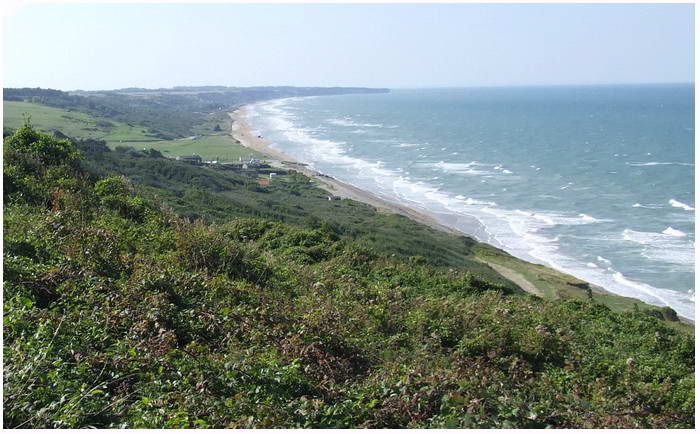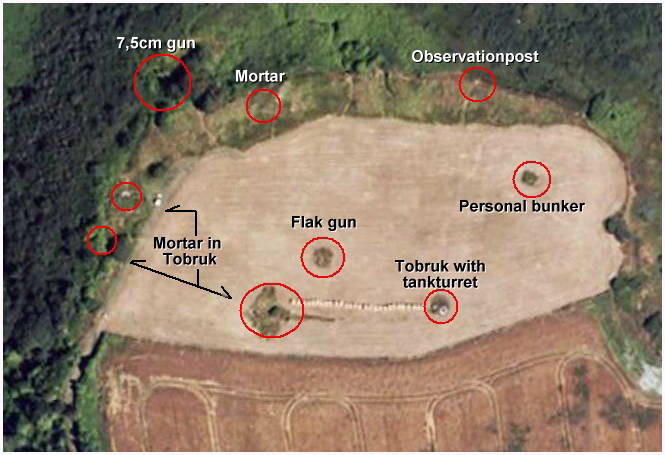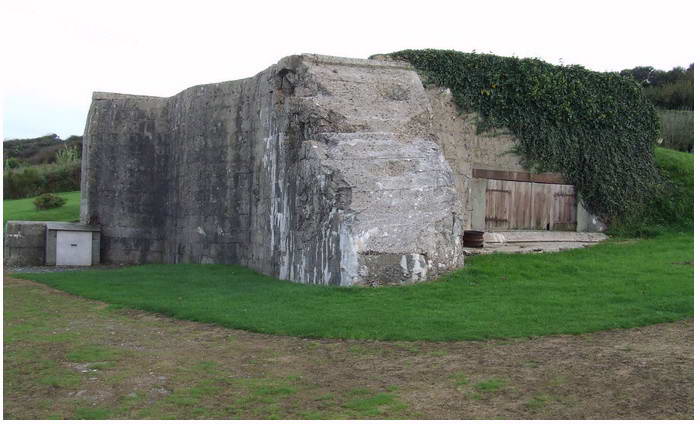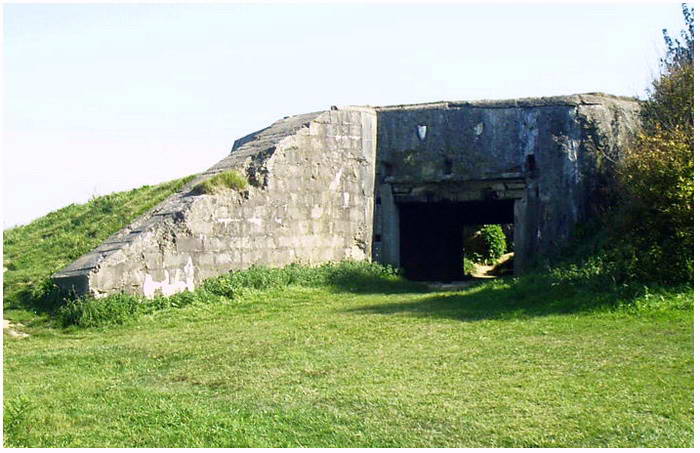Most people associate D-Day with one beach, Omaha Beach. Of
the two landing beaches the American army would have to take,
Utah and Omaha, the last sector was the most difficult and had
the most casualties on June 6th of all the landing beaches.

STE. HONORINE-DES-PERTES
As mentioned before on the page where we visited Port-en-Bessin, there was also a fuel off loading point
at Ste. Honorine-des-Pertes. This village is some 5 km west of Port-en-Bessin on the D 514. Here are a few
interesting point to visit, but also difficult to find.
 The right lane has changed, but Ste. Honorine-des-Pertes has little changes
The right lane has changed, but Ste. Honorine-des-Pertes has little changes
 In the red square is the house of the 'loony' Frenchman, in the movie 'The Longest Day'
In the red square is the house of the 'loony' Frenchman, in the movie 'The Longest Day'
One of the easy places to locate is the small bay of Ste. Honorine-des-Pertes.
When you approach the little village, notice the little parking lot on the right (when driving westwards).
At the end is a small road to the right (not for campers) that leads downhill. A hundred meters before you
reach the bay, near the crossing to the right, on the left you’ll find a big (school?) building. Park here.
Ste. Honorine-des-Pertes was liberated on 7 June by the 16th Regimental Combat Team, 1st US Division.
Here was located a fuel point for the ‘minor’ PLUTO system (from ships that were anchored in front of the coast).
This so called
Tombola system consisted of two pipelines of 6 iches each.These came together with lines from Port-en-Bessin,
in Mont Cauvin, near Etréham.
 June 1944, 'Tombola' pipelines in Ste. Honorine-des-Pertes
June 1944, 'Tombola' pipelines in Ste. Honorine-des-Pertes
On 25 June the first fuel was transported through Honorine-des-Pertes. Because of the setback to bring the
‘major’ PLUTO at work from Cherbourg, the ‘minor’ was becoming much more important. Calculated was that the
‘minor’ system would transport around 6000 barrels of MT80 aircraft fuel. But at the end of Juli, this was
doubled. Even after D+41 (the date is was expected that this ‘minor’ system could close) it was still full
in operation.
To commemorate PLUTO, a sign with some info can be found on the edge of the parking lot.
 The house of the enthusiastic flag waving Frenchman. in The Longest
Day
The house of the enthusiastic flag waving Frenchman. in The Longest
Day
From this parking lot go into the small street leading right. At the end of this road stands
a house used in the movie 'The Longest Day'. In this scene an over-enthusiastic
Frenchman is waving as a lunatic with a flag towards the invasion fleet. Pass this house and head back
to the D 514. Continue westwards, again through
Ste. Honorine-des-Pertes, heading for Colleville-sur-Mer.
From Widerstandsnest 60, east of Colleville-sur-Mer, and some
6 kilometres to the west, at Vierville-sur-Mer, runs OMAHA Beach, the sector designated to the
Americans. OMAHA Beach was divided into the sectors: 'FOX', 'EASY', 'DOG' and ‘CHARLIE’. Also,
Pointe du Hoc was to be found in this sector. Below a tour takes you from Wn 60 near Colleville-sur-Mer all the way to Grandcamp-Maisy.
Widerstandsnest 60
 A map with the positions of Wn 60, Wn 61 and Wn 62
(Google Earth)
A map with the positions of Wn 60, Wn 61 and Wn 62
(Google Earth)
A little difficult location to find is Widerstandsnest 60 where Major Pluskat supposed to have
observed the invasion fleet
heading towards his coast (one of the most famous scenes from the movie 'The Longest Day'). The general opinion is
that Pluskat was in his bunker when he saw the armada of ships closing
in on his position, but there are writers, mostly German, like Helmut
Freiherr von Keusgen, who claim to have spoken to witnesses, that Pluskat
was with some ladies of pleasure at that time. But however you think about it,…
for the one who wants to visited every aspect of the invasion, a visit to Wn 60 is recommended.
 Perhaps the best view at Omaha Beach, is from Wn 60
Perhaps the best view at Omaha Beach, is from Wn 60
Follow the D 514 westwards. After Ste. Honorine-des-Pertes and the village of Grand Hameau,
you come across a small road ('Cabourg') to the right (it is located in a bend of the road, just before
you enter Colleville-sur-Mer, and helpfull is the red fire hydrant at the corner).
Turn into this small road, and follow the winding road through a wooded area. Drive all the
way to the end (many curves, but keep right) where the wooded area goes over into farmed ground.
When you hit the right spot, you will notice a path leading steep downhill, follow this a
couple of meters but DO NOT GO ALL THE WAY DOWN, this leads
towards Wn 61! Take the path that moves to the right, a bit uphill, which
has a horizontal beam, pass this barrier, and after some 50 meters you are on Wn 60.
 A tree stood once in the entrance of a Tobruk (removed a couple of years ago)
A tree stood once in the entrance of a Tobruk (removed a couple of years ago)
Wn 60 is located on top of the cliff at a height of some 60 meters and has one of the best
views over Omaha Beach. Wn 60 was in the most eastern border of the sector Omaha Beach, and what was
known as FOX-Red. Further to the east the cliffs were to steep and not suitable for a landing towards
Port-en-Bessin (with the exception of the little bay of Ste. Honorine-des-Pertes).
 Wn 60 with the locations of the weapons
Wn 60 with the locations of the weapons
(still some trenches can be seen)
(Google Earth)
On 6 June 1944 some forty German Wehrmacht sodiers were active here. Two company’s of the 16th Regiment,
1st Division, headed around 08.00 hours via a path west of Wn 60 and attacked it from the back and around
09.00 hours it was taken. Of the 40 Germans, 31 were taken prisoner, the others killed in the battle.
 What’s left of Pluskat his little observation post of Wn 60
What’s left of Pluskat his little observation post of Wn 60
The heaviest weapons in Wn 60 were a 7,5cm gun, a couple of mortars in Tobruks and a few machineguns.
Central of Wn 60 a 2cm Flak 38 gun was in place. At the edge a small ruin of the observation post
can be found where Pluskat saw the invasion fleet approaching. Still some zig-zag trench marks
can be found. In the southeast corner a Tobruk was placed with a tankturret (probably an R-35) to defend the complex.
 The central placed mortar bunker can be visited
The central placed mortar bunker can be visited
Sector 'FOX en EASY'
Wn 61, Colleville-sur-Mer
Return to the D 514 and move further towards Colleville-sur-Mer.
In the center of the village follow the signs ‘La Plage’, to the right, downhill.
On the bottom you are more or less instructed to go left, towards Wn 62, the 1st Division
monument and the American Cemetery. But move further downhill, a 50 meters passed the crossing
to the left, go right, towards the sail school in the distance, park your car here, and walk
to the beach and a 50 meters to the right.
This is Wn 61. It had an 8,8cm PAK 43/41 in an H 677 casemat plus a 5cm KwK in a Tobruk.
This and Wn 62 were responsible for the heavy cassulties inflicted during the first waves Americans
that landed here, in de sector FOX and Easy.
Between Wn 61 and Wn 62 was exit E-3. The 8,8cm of Wn 61 was put out of action around 07.10 hours by
a DD Sherman tank under command of Staff Sergeant Sheppard of the 741st Tank Battalion (one of the five
of the 32 dropped into the sea). The damage H 677 is on private property, but is good visible from the beach.
The bunker behind de H 677 is now in use a foundation for a bungalow.
 The H 677 from Wn 61 which had an 8,8cm PAK 43/41
The H 677 from Wn 61 which had an 8,8cm PAK 43/41
In this area. the sector FOX-Green, some famous pictures were taken
of engineers rescuing colleague soldiers from the sea. Half a mile further,
below Wn 60, in the sector FOX-red, there was also more of a rescue mission
then that a coherent fighting unit was composed.
 At the pebble beach
at Wn 61, FOX-Green, it was a rescue mission
At the pebble beach
at Wn 61, FOX-Green, it was a rescue mission
Cold, wounded and miserable groups of men at FOX-Red waited for what would happen
next. It was mixed bag of men from the 16th (1st Div.)
and the 116th Regiment (29th Div.). When the tide came in, these men were forced to
move to FOX-Green. This movement brought some spirit back in these men, and slowly
it became a fighting force again.
 Below Wn 60 at FOX-Red,
there was a large group of disillusioned men.
Below Wn 60 at FOX-Red,
there was a large group of disillusioned men.
Then and Now

Return through the ‘draw’ (Exit E-3) for a visit to Wn 62 and the casemats and monuments at
this complex, and the American National Cemetery.
For more details on the American units
who stormed Omaha Beach
and the German defence:
CLICK HERE
(please, return here, when done)
Wn 62, Colleville-sur-Mer
(east of the American National
Cemetery)

The German complex, Widerstandsnest 62 in the
sector 'FOX-Green', was on 6 June a though nut to crack.
The guns from this complex were all positioned on the beaches of Omaha.
Here are some good preserved bunkers to be found, and also some trench marks
are still visible in the grass. It was halfway in the morning before American
troop overran this place. Of the twenty Germans still alive, only three were
not wounded.
Just below the cliff are two large H 669 casemats. Both had once 7.65 cm guns
from Czech making.
 The lowest
H 669 casemat of Wn 62
The lowest
H 669 casemat of Wn 62
Also at Wn 62 was a 5cm gun and two 5cm mortars. Furthermore, the machinegun
fire was murderess from this complex. The concrete of the H 669 casemats is badly
damaged by American heavy guns. In the top casemat a enormous impact inside of it can be found.
 The rear of
one of the H 669 casemat at Wn 62.
The rear of
one of the H 669 casemat at Wn 62.
At the horizon, Vierville-sur-Mer, Omaha Beach
On the top casemat is a monument, to honour the 5th Engineer
Brigade. Another monument at this complex is the eye catching needle for the 1st Infantry Division (Big Red One).
  Two monuments at Wn 62, on
the right the one for the 1st Infantry Division
Two monuments at Wn 62, on
the right the one for the 1st Infantry Division
This is also the sector where probably the most famous pictures were
taken during the First hours of the landings at Omaha Beach. Robert Capa shot
here the horror on film, but just 10 came out of the process of development in
a lab in England. But these few pictures became the icons which for every will
be associated with Bloody Omaha.
 My painting after a famous picture by Robert Capa
My painting after a famous picture by Robert Capa
For more on the famous pictures by Robert Capa:
CLICK HERE
(Please, return later back to this page)
To continue the tour around Omaha Beach,
The American National Cemetery,
St. Laurent-sur-Mer and Vierville-sur-Mer
'CLICK BELOW'
on
The Spirit of American Youth Rising From the Waves
|